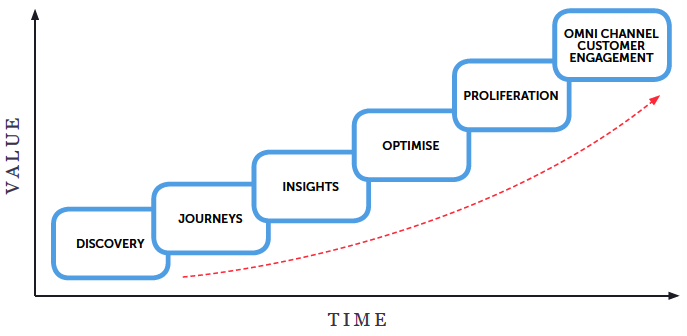Execute Your Consumer Experience Strategy
Learning Objectives
After completing this unit, you’ll be able to:
- Describe the key resources you need to improve the consumer experience.
- Describe the four steps to implementing a consumer engagement strategy.
Once you have an RTIM solution, you’re ready to develop a consumer experience strategy. The success of your strategy hinges on two factors: your team and the actual plan to activate real-time interaction management. Let’s dive into each.
Teams and Trailblazers
Delivering great consumer experiences takes a united effort across teams and departments. You need somebody who can align your teams internally and make everyone believe in the same mission. That sounds like a job for a Trailblazer! What is a Trailblazer? A Trailblazer is a leader, an innovator, a motivator, someone with vision.
For many brands, Trailblazers are people in the role of chief marketing officer, chief design officer, chief experience officer, or chief innovation officer. They, or others like them, have a vision for transforming the way a team thinks about personalization. Plus, they can govern strategy across the marketing, sales, and service departments. They drive decisions and execution across teams, and they care about personalization in terms of how it affects revenue and customer retention.
Your consumers think of you as one brand, not different brand experiences across different touchpoints owned by different departments. So the role of the Trailblazer must be to create seamless interactions. The goal is for consumers to experience every touchpoint as part of a continuous, flawlessly connected experience across channels. RTIM can help consumer-centric companies meet that goal. This, in turn, increases brand loyalty from consumers—which makes Trailblazers happy.
Your Plan
It’s important to approach your strategy with a clear understanding of scope and objective. Hint: Being laser-focused on a specific use case in your consumer experience is a great way to start. Choose one goal, and make it easy to measure and achieve. Is it a real-time offers program that can increase campaign conversion, or something else?
Once you’ve successfully identified which part of the consumer journey to personalize, it’s easier to move on to a larger project. You’ll have context for the consumer, a better understanding of how to execute and achieve your goals, plus you’ll already know what’s worked for you in the past.
Now let’s walk through the steps to building customer engagement for your brand.
The Four Steps to Customer Engagement
Step 1: Discovery
The Thinking Side
Discovery is the process of understanding your brand, establishing a baseline view of what you need and want to change. It’s about identifying that destination, aligning it to your business strategy and objectives.
Start by building an understanding of where you are today. What are the current obstacles to establishing your customer engagement strategy? What do you already know about your customers? What value do they currently place in you? What are you trying to improve, and how will those improvements be reflected in customer satisfaction scores? Who are the stakeholders in each business unit? Sales, Service, Marketing, eCommerce, Finance, IT—these are the stakeholders you need to bring to the party.
You’re trying to discover where your company’s at, so you can quickly start to implement a customer engagement strategy. So build discussions around the following four key areas of impact to the business.
 |
Business culture and governance |
 |
Execution ability |
 |
Analytics and insight |
 |
Technology |
The Practical Side
Do you already have a customer engagement strategy? Have you executed against the strategy? If you have, can you measure and analyze results against those actions? Do you have the right technology, people, and processes to support the business and, more importantly, support your customers?
Based on those few key questions, ask yourself how advanced your customer engagement really is. The answer should help you identify how much help you’re going to need in shaping and delivering your customer engagement plans. Even if you’re well advanced, your fitness should indicate the type of help you need to take customer engagement to the next level.
Step 2: Scope Setting
There’s a lot to think about when you’re building your customer engagement strategy, but if you take it step by step, everything should fall into place easily and quickly.
Don’t try to do everything at once. Give yourself (and the rest of the business) time to consider and respond to what needs to be done. Just by agreeing on the immediate priorities for each stage makes life a lot easier. Simple things like deciding what “good” looks like, agreeing on the drivers behind customer engagement, and knowing how to measure success can help the project run smoothly.
Once you understand the experience your customers want with your brand, you can start to deliver it. So take time to view and understand the customer journeys in real time: How do customers interact? What are their needs? Develop customer hypotheses, and identify communications channels and how to integrate journeys across all of them.
Don’t do this in isolation. Everyone should agree on the scope. By the end of this scope-setting phase, you should have buy-in from all the business stakeholders. Their involvement greatly helps your ability to deliver (and succeed).
Step 3: Deploy and Optimize
At this step, you have selected a technology solution like Salesforce's Marketing Cloud Personalization, and you are starting to use it. Take time to identify all the technical requirements and schedule optimization for the activities you agreed on during the previous scope-setting phase.
You may need to integrate technology across the business at different times, so make sure the organization’s stakeholders remain on-board and part of the program. Marketing Cloud Personalization easily works with any CRM or system of record, but if you have a more complex need, just ramp up at your own pace.
You are personalizing channels and generating customer engagement data now, so make sure data analysis is factored into your scheduling and reporting processes. Be clear on where the responsibilities lie for analytics, and make sure, repeatedly, that you’re receiving the feedback you need from the business to meet the value measures.
This is the plumbing part of your customer engagement strategy, where you ensure that everything connects, works, and doesn’t leak. Take the time to switch on and test new channels progressively; you don’t need to do it all at once. Build in a small amount of time for training.
Step 4: Customer Value
Remember all that work you put into establishing, agreeing on, and setting measures for what “good” looks like? This is where it pays off. You’ve been tracking against success criteria, and you now can demonstrate to the business that the investment has been worthwhile (plus you’ll look like a customer engagement rock star). But customer engagement doesn’t stop here. In many respects, you’re just getting started.

New customer insights help you establish more customer-centric processes and see lasting customer value. Your business can adapt, adjust, and change to meet customer needs and provide a more personalized, relevant, and ongoing conversation.
You can uncover Customer Champions who make sure the business responds to process changes in the way it should. As you (and your stakeholders) start to see the value of customer engagement, you can start to organize your business in a more customer-centric way.
You can move beyond technology now. Instead of integrating and supporting the technology as you did in the previous step, the technology can now support you and help you manage every customer interaction throughout the journey. So make sure you’ve selected a solution that is scalable and can grow with you.
You can learn to act and respond in real time to the data, so use the technology to make the right, insight-driven decisions appropriate for each customer. If you’re using Marketing Cloud Personalization, the technology automatically takes action and initiates the right customer conversation at the right time. But don’t think of this as an end point—customer engagement is dynamic. Think of it as a cycle of improvement and proliferation.